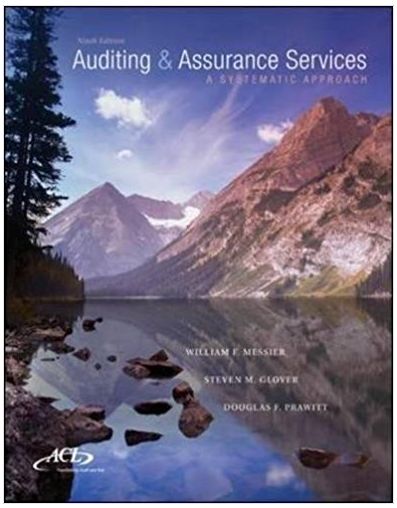Multiple Choice: 1. Before accepting an audit engagement, a successor auditor should make specific inquiries of the
Question:
1. Before accepting an audit engagement, a successor auditor should make specific inquiries of the predecessor auditor regarding the predecessor’s
a. Awareness of the consistency in the application of generally accepted accounting principles between periods.
b. Evaluation of all matters of continuing accounting significance.
c. Opinion of any subsequent events occurring since the predecessor’s audit report was issued.
d. Understanding as to the reasons for the change of auditors.
2. A written understanding between the auditor and the entity concerning the auditor’s responsibility for the discovery of illegal acts is usually set forth in a(n)
a. Internal control letter.
b. Letter of audit inquiry.
c. Management letter.
d. Engagement letter.
3. Miller Retailing, Inc., maintains a staff of three full- time internal auditors who report directly to the audit committee. In planning to use the internal auditors to help in performing the audit, the independent auditor most likely will
a. Place limited reliance on the work performed by the internal auditors.
b. Decrease the extent of the tests of controls needed to support the assessed level of detection risk.
c. Increase the extent of the procedures needed to reduce control risk to an acceptable level.
d. Avoid using the work performed by the internal auditors.
4. During the initial planning phase of an audit, a CPA most likely would
a. Identify specific internal control activities that are likely to prevent fraud.
b. Evaluate the reasonableness of the entity’s accounting estimates.
c. Discuss the timing of the audit procedures with the entity’s management.
d. Inquire of the entity’s attorney if it is probable that any unrecorded claims will be asserted.
5. When planning an audit, an auditor should
a. Consider whether the extent of substantive procedures may be reduced based on the results of the internal control questionnaire.
b. Determine overall materiality for audit purposes.
c. Conclude whether changes in compliance with prescribed internal controls justify reliance on them.
d. Prepare a preliminary draft of the management representation letter.
6. As generally conceived, the audit committee of a publicly held company should be made up of
a. Representatives of the major equity interests (preferred stock, common stock).
b. The audit partner, the chief financial officer, the legal counsel, and at least one outsider.
c. Representatives from the entity’s management, investors, suppliers, and customers.
d. Members of the board of directors who are not officers or employees.
7. Which of these statements concerning illegal acts by clients is correct?
a. An auditor’s responsibility to detect illegal acts that have a direct and material effect on the financial statements is the same as that for errors and fraud.
b. An audit in accordance with generally accepted auditing standards normally includes audit procedures specifically designed to detect illegal acts that have an indirect but material effect on the financial statements.
c. An auditor considers illegal acts from the perspective of the reliability of management’s representations rather than their relation to audit objectives derived from financial statement assertions.
d. An auditor has no responsibility to detect illegal acts by clients that have an indirect effect on the financial statements.
8. The engagement partner and manager review the work of engagement team members to evaluate which of the following?
a. The work was performed and documented.
b. The objectives of the procedures were achieved.
c. The results of the work support the conclusions reached.
d. All of the above are correct.
9. Tolerable misstatement is
a. The amount of misstatement that management is willing to tolerate in the financial statements.
b. Materiality for the balance sheet as a whole.
c. Materiality for the income statement as a whole.
d. Materiality used to establish a scope for the audit procedures for the individual account balance or disclosures.
10. Which of the following is not a qualitative factor that may affect an auditor’s establishment of materiality?
a. Potential for fraud.
b. The company is close to violating loan covenants.
c. Firm policy sets materiality at 4 percent of pretax income.
d. A small misstatement would interrupt an earnings trend.
Audit Report
The audit report is issued by a certified public accountant who is appointed by the shareholders to provide assurance upon the truth and fairness of the financial statements prepared by the managers of the company. Audit report contains the... Financial Statements
Financial statements are the standardized formats to present the financial information related to a business or an organization for its users. Financial statements contain the historical information as well as current period’s financial... Balance Sheet
Balance sheet is a statement of the financial position of a business that list all the assets, liabilities, and owner’s equity and shareholder’s equity at a particular point of time. A balance sheet is also called as a “statement of financial...
Fantastic news! We've Found the answer you've been seeking!
Step by Step Answer:
Related Book For 

Auditing and Assurance Services A Systematic Approach
ISBN: 978-1259162343
9th edition
Authors: William Messier, Steven Glover, Douglas Prawitt
Question Posted:





